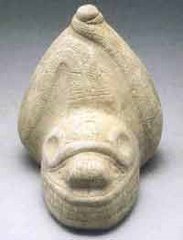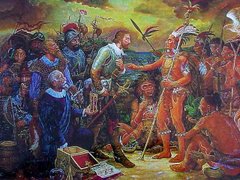 DID YOU KNOW - The pineapple was spread by Indigenous Peoples up through South and Central America to the Caribbean before Columbus arrived. It is suggested that the fruit was originally developed in southern Brazil and Paraguay where wild relatives occur. In 1493 Columbus encountered the fruit on the island of Guadaloupe and carried it back to Spain. The pineapple was soon distributed around the world on sailing ships that carried it for protection against scurvy. The Spanish introduced it into the Philippines and possibly to Hawaii and Guam early in the 16th Century. The pineapple reached England in 1660 and began to be grown in greenhouses around 1720. In the Taino language the pineapple is called Iaiama (Yayama). – UCTP Taino News © 2010
DID YOU KNOW - The pineapple was spread by Indigenous Peoples up through South and Central America to the Caribbean before Columbus arrived. It is suggested that the fruit was originally developed in southern Brazil and Paraguay where wild relatives occur. In 1493 Columbus encountered the fruit on the island of Guadaloupe and carried it back to Spain. The pineapple was soon distributed around the world on sailing ships that carried it for protection against scurvy. The Spanish introduced it into the Philippines and possibly to Hawaii and Guam early in the 16th Century. The pineapple reached England in 1660 and began to be grown in greenhouses around 1720. In the Taino language the pineapple is called Iaiama (Yayama). – UCTP Taino News © 2010Thursday, March 25, 2010
Iaiama: The Pineapple
 DID YOU KNOW - The pineapple was spread by Indigenous Peoples up through South and Central America to the Caribbean before Columbus arrived. It is suggested that the fruit was originally developed in southern Brazil and Paraguay where wild relatives occur. In 1493 Columbus encountered the fruit on the island of Guadaloupe and carried it back to Spain. The pineapple was soon distributed around the world on sailing ships that carried it for protection against scurvy. The Spanish introduced it into the Philippines and possibly to Hawaii and Guam early in the 16th Century. The pineapple reached England in 1660 and began to be grown in greenhouses around 1720. In the Taino language the pineapple is called Iaiama (Yayama). – UCTP Taino News © 2010
DID YOU KNOW - The pineapple was spread by Indigenous Peoples up through South and Central America to the Caribbean before Columbus arrived. It is suggested that the fruit was originally developed in southern Brazil and Paraguay where wild relatives occur. In 1493 Columbus encountered the fruit on the island of Guadaloupe and carried it back to Spain. The pineapple was soon distributed around the world on sailing ships that carried it for protection against scurvy. The Spanish introduced it into the Philippines and possibly to Hawaii and Guam early in the 16th Century. The pineapple reached England in 1660 and began to be grown in greenhouses around 1720. In the Taino language the pineapple is called Iaiama (Yayama). – UCTP Taino News © 2010
Labels:
Guadaloupe,
Iaiama,
pineapple,
Taino,
Taino Nation,
Yayama
Thursday, February 04, 2010
Canadian First Nations Recognize Taino Treaty
DID YOU KNOW - A peace treaty signed in 1533 in the Caribbean between Taino Kasike Guarokuia (Enriquillo/Henri) and a representative of the King of Spain was recognized as the “first international treaty in the Americas between Indigenous people and Europeans" in a resolution by over 100 delegates to the Assembly of First Nations (AFN) National Treaty Conference, held in Yellowknife, Northwest Territories on Oct. 28, 1998. The AFN resolution recommended recognition of the Taino-Spanish treaty to the United Nations rapporteur, Miguel Alfonso Martinez of Cuba, who was completing his final report on treaties with Indigenous peoples around the world. One fourth of Canada's Indian chiefs attended the conference, which discussed national and international treaty implications and strategies. The resolution, moved by Akaitcho Territory Government Grand Chief Felix Lockhart and seconded by Chief Fred Sangris (Yellowknives Dene), reads in part: "AFN recommends that the "1533 Bahoruco Treaty” be recognized as the first Treaty in the Americas between Indigenous Peoples and Europeans in the Final Report of the U.N. Special Rapporteur.” - UCTP Taino News © 2010
Friday, January 15, 2010
Taino Recognition

DID YOU KNOW: The United Confederation of Taino People is recognized by the U.S. Congress, U.S. Census Bureau, USA.gov, and several U.S. State and local governments and agencies. In Boriken (Puerto Rico), the Confederation is recognized by the Municipality of Utuado and the Puerto Rican House of Representatives. The work of Confederation is recognized by the Government of Canada and by inter-governmental organizations such as the United Nations and Organization of American States (OAS). In the promotion of indigenous Taino sovereignty, the UCTP has also entered into treaties with Caribbean Indigenous Governments and Tribal Organizations in Dominica, Trinidad, Barbados, and Bermuda as well as with related South American mainland communities in Venezuela and Guyana. - UCTP Taino News ©2010
Thursday, December 17, 2009
The Caribbean

Did You Know: The word “Caribbean” is said to be derived from the name of one of the dominant indigenous (Amerindian) groups in the region at the time of European contact during the late 15th century, the Caribs. While their continues to be debate among scholars as to the origin of the word, at least one of the communities currently identified as "Carib" call themselves Kalinago. The island of Boriken (Puerto Rico) itself was also identified as Carib in some old maps. Some of the other Indigenous Nations identified in the region are Arawak, Ciboney, Galibi, Garifuna, Igneri, Lucayan, and the Taino. - - UCTP Taino News © 2009
Wednesday, November 18, 2009
Manatee or Manati

Did you know: Manatees are said to have evolved from four-footed land mammals more than 60 million years ago. According to scientists their closet relatives are reported to be the dugong, and the African Elephant (distantly).There are three species of manatees, including the West Indian manatee. The Florida manatee, which can eat up to 100 pounds (45 kilograms) of vegetation a day and weigh a half-ton on average, is a subspecies of the West Indian manatee. Manatees can move readily between salt water and fresh water, but they can't survive in cold water for long periods. In the U.S. the manatee is still listed federally as an endangered species yet in the state of Florida it it is listed only as a “threatened” species. The word manatee is considered an indigenous "loan word" found in both the Taino and Carib languages. Among the Carib the term Manati is said to translate to mean "breast." Traditionally, the Taino consider this animal as sacred as North American Indigenous Peoples consider the buffalo sacred. Prior to colonization Taino hunters used every part of the animal for food, tools, and other resources. – - UCTP Taino News © 2009
Wednesday, October 14, 2009
Tiburon
DID YOU KNOW: The car companies Porsche and Hyundai both have sports cars with Taino names. Porsche has the Cayman which is the Taino word for crocodile (who reside in cays - another Taino word still in use today) and the Hyundai has the Tiburon, which is one of the Taino words for shark. We have yet to see a car named the Manati or the Coki but it's still pretty cool to see our ancient words being used in the modern world. - - UCTP Taino News © 2009
Labels:
Cayman,
Coki,
Coqui,
Hyundai,
manatee,
manati,
Porsche,
Tiburon,
UCTP Did You Know Files,
UCTP Taino News
Subscribe to:
Posts (Atom)






